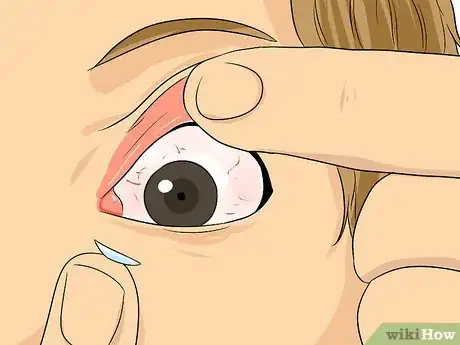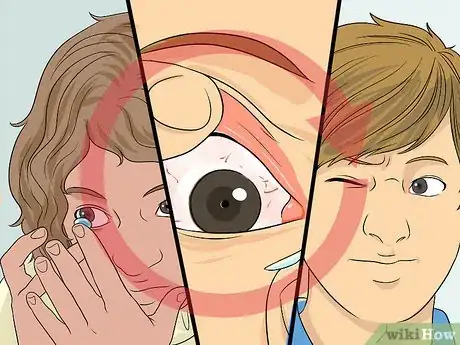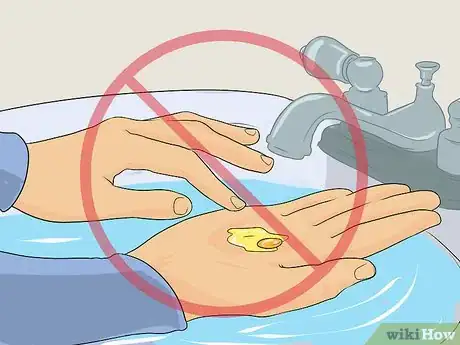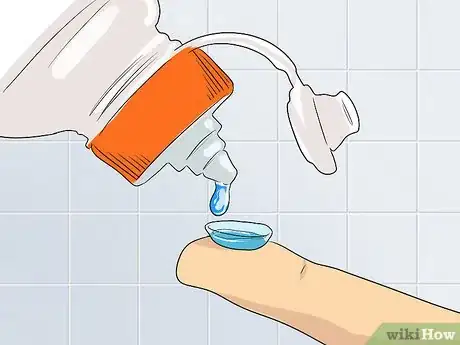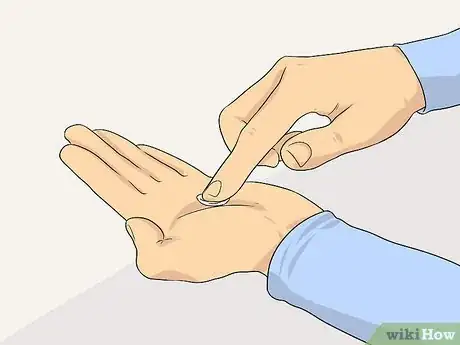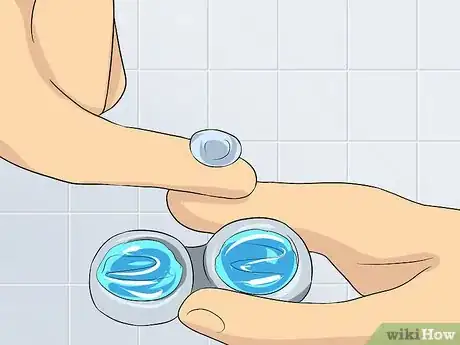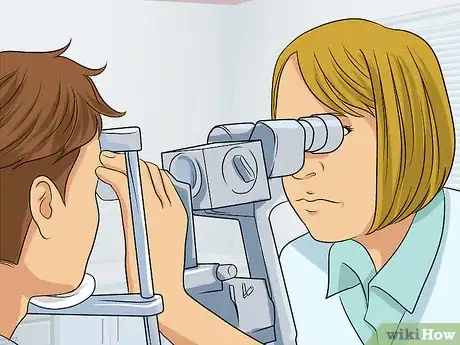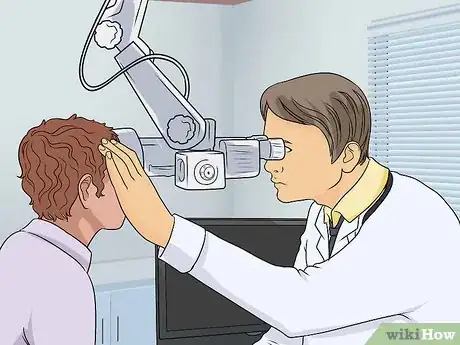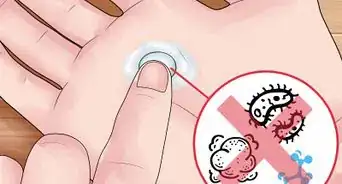This article was medically reviewed by Shaune Wallace, OD. Dr. Wallace is an Optometrist in Nevada with over 14 years of optometry experience. He received his OD from the Southern California College of Optometry in 2006 and is a member of the American Optometric Association.
There are 7 references cited in this article, which can be found at the bottom of the page.
This article has been viewed 22,882 times.
Orthographic lens (Ortho-k) are medical contact lenses (approved by the FDA) that are worn at night. While you sleep, Ortho-k contacts mold and temporarily reshape your cornea, so that you can see clearly the following day without the aid of contacts of glasses.[1] Some individuals can even go two or three days without wearing contacts or glasses after a single night of wearing Ortho-k contacts, depending on the severity of their myopia or astigmatism. Ortho-k contacts are rigid, unlike normal prescription contact lenses that you would wear during the day—this means that Ortho-k contacts are more challenging to insert correctly. Ortho-k lenses also require more specific maintenance than regular contact lenses.
Steps
Putting the Lenses in Your Eyes
-
1Clean your face and hands. Since you will be touching your eye directly when inserting the contact lenses, you’ll want to avoid getting any dirt or germs into your eyes. Wash your hands with soap for at least 30 seconds, and dry them on a clean towel.
- If you have long hair, tie it up while you’re putting in the contact lenses. Hair can distract you by getting in your eyes, and could also transmit dirt and germs onto the lenses.
-
2Use your left hand to hold your right eye open. Place your left index finger gently against your right eyelid, and gently pull the eyelid up so your eye is as far open as possible. At the same time, place your left thumb under your lower lid and gently pull it down.
- It’s important that you keep your hands steady during this procedure. Keep your eye from blinking as you insert the contact lens.
Advertisement -
3Gently place the lens over your iris. Set one of your contact lenses onto the tip of your index finger of your right hand. With your index finger, carefully lift it to your eye right. If the lens is damp, it should adhere to your finger and not slip around. Move the lens forward until it gently cups your cornea and is firmly in the center of your eye.
- Your iris is the colored section in the center of your eye, which surrounds the pupil. The iris dilates (opens and closes) the pupil to adjust the amount of light that enters your eye.[2]
- Your cornea is clear, dome-shaped tissue that covers the front of your eye. The cornea allows light to enter your pupil, and helps focus light rays to assist the eye’s focus.[3]
- Never force the lens into your eye.
- It’s okay to repeat the procedure multiple times if you don’t successfully apply the lens the first time.
-
4Blink your eye to center and wet the lens. Pull your finger back, as the lens should have adhered to the wet surface of your eye at this point. Blink several times, and the contact lens should center itself naturally by settling over the curved shape of your eye.
- If the lens does not center itself when you blink a few times, or if it feels uncomfortable or isn’t centered over your cornea, you’ll need to pull the lens out and try again. To remove the lens, grip it lightly by the sides and pull it lightly away from your cornea.
-
5Repeat the process for your next eye. You’ll need to use your thumb and index finger to hold your left eye open, then gently insert the lens over your iris. If your lenses are marked “R” and “L,” put the correct lens in the corresponding eye.
- If you are left handed, you may find it easier to spread your eyelids apart with your right hand, leaving your left index finger free to insert the lenses.
-
6Go to sleep. Ortho-k lenses are designed to be worn for an extended period of time while you’re sleeping, so you should only put them in immediately before you’re going to sleep. You need to sleep for at least 8 hours for the lenses to work.
Caring For Your Ortho-k Lenses
-
1Do not clean your Ortho-k lenses in water. Although tap, bottled, and distilled water are safe for consumption and often used to clean glasses and standard contact lenses, Ortho-k lenses should be kept away from all types of water.[4]
- If the lenses come in contact with water, and rest in your eyes for 8 or more hours, it will put you at risk for a serious infection called Acanthamoeba keratoconjunctivitis.[5]
- Instead, your lenses should be stored and cleaned in a sterile saline solution.[6] Such a solution should have been provided to you when you first bought your Ortho-k lenses, and replacement saline solution can be purchased at your eye doctor’s office or at any pharmacy.
-
2Clean your Ortho-k lenses after each use. Your optometrist should have given you a cleaning set to use with your Ortho-k lenses when you first purchased them. This kit will contain a cleaning solution, a saline solution (for rinsing and storage), a lens-storage case, and possibly Ortho-k-lens-specific lubricating eye drops.[7]
-
3Rub the provided cleansing solution on each contact lens. For best effect, drip 2–3 drops of cleaning solution onto each lens, and then rub the solution on both sides with your fingers.[8] Rub the solution around for at least 1 minute. The solution should start to foam as you rub the lenses.
- Cleaning your lenses will remove any dirt or oils that are on the Ortho-k lenses, and also remove any oil, hair, or skin that may have stuck to the lenses while in your eyes.
- Rinse the cleaning solution off using the provided saline solution. It’s important to thoroughly remove the cleaning solution, as the abrasive cleaning chemicals will be harmful to your eyes.[9]
-
4Soak the lenses when they are not in use. When you are not asleep, the Ortho-k lenses should be safely stored in the storage case that you have been provided.[10] Fill each side of the storage case with saline solution (or another storage solution that has been provided), and, after you’ve cleansed the lenses, gently set them in the solution and screw the top on.
- This will keep the lenses from being damaged, and allow the lenses to remain sterile.
Deciding if You Should Use Ortho-K Lenses
-
1Ask your optometrist if your eyes are myopic. Orthokeratology is most often used to correct myopia (nearsightedness) in adults, so if you suffer from myopia, Ortho-k lenses may be the best solution.[11] Ortho-k lenses are also effective at treating astigmatism and hyperopia.
-
2Pursue orthokeratology before laser refractive surgery. Although Ortho-k lenses only provide a temporary solution to myopia or astigmatism and need to be worn nightly (or every other night), they are much less expensive than laser refractive surgery (such as LASIK), and may have comparable results.[14]
- Unlike eye surgery, the results of orthokeratology are temporary and reversible.
- Ortho-k treatment is painless and does not have any recovery period.
- Children can use Ortho-k lenses, while surgery is only available to individuals over 18.
- If you’d like to try Ortho-k lenses, your optometrist may ask you to complete a trial period with the Ortho-k lenses before giving you a full prescription. This will generally comprise a 1–2 week trial.[15]
-
3Consider Ortho-k lenses if your child has progressive myopia. Ortho-k lenses can be very effective for children in the age range from 8–12 who suffer from progressive myopia (worsening nearsightedness). For children, not only can Ortho-k lenses improve daytime vision (as for adults), but the lenses can also prevent or slow the development of adulthood myopia.[16]
- If you suspect your child is myopic, have them examined by an optometrist.
Warnings
- Don’t forcibly push the Ortho-k lens into your eyes. The contacts could cut your cornea and cause serious damage to your eye. The hard lenses could also break, leaving pieces of glass dangerously near your cornea.⧼thumbs_response⧽
References
- ↑ http://www.allaboutvision.com/contacts/orthok.htm
- ↑ http://www.visionaware.org/info/your-eye-condition/eye-health/anatomy-of-the-eye/125
- ↑ http://www.visionaware.org/info/your-eye-condition/eye-health/anatomy-of-the-eye/125
- ↑ https://www.youreyesite.com/eye-care-information/caring-ortho-k-lenses/
- ↑ https://www.youreyesite.com/eye-care-information/caring-ortho-k-lenses/
- ↑ https://www.youreyesite.com/eye-care-information/caring-ortho-k-lenses/
- ↑ https://www.youreyesite.com/eye-care-information/caring-ortho-k-lenses/
- ↑ https://www.youreyesite.com/eye-care-information/caring-ortho-k-lenses/
- ↑ https://www.youreyesite.com/eye-care-information/caring-ortho-k-lenses/
- ↑ https://www.youreyesite.com/eye-care-information/caring-ortho-k-lenses/
- ↑ http://www.allaboutvision.com/contacts/orthok.htm
- ↑ http://www.allaboutvision.com/conditions/astigmatism.htm
- ↑ http://www.allaboutvision.com/conditions/hyperopia.htm
- ↑ http://www.visiontherapeutics.com/ortho-k-lenses.html
- ↑ http://www.contactlenses.org/orthok.htm
- ↑ http://www.contactlenses.org/orthok.htm


